Winter can be hard on buildings and budgets. Getting your commercial property for winter ready now keeps tenants safe and operations steady. Use this guide to plan early, act fast, and avoid costly surprises.
Preparing Commercial Property For Winter
This section sets up the checklist to help you transition from quick wins to more complex tasks. It supports commercial building winterization for offices, retail, industrial, and mixed-use sites. Follow each step, track dates, and document fixes so your commercial property for winter stays ahead of the weather.
Inspect the Building Exterior

Start with the shell. Walk the exterior and look for gaps, failed sealant, loose siding, and damaged flashing. A tight envelope helps your commercial property for winter hold heat and resist wind-driven rain and snow.
Service Heating Systems and Controls
Schedule a tune-up for boilers, furnaces, heat pumps, and unit heaters. Replace filters, test combustion, and calibrate thermostats and BAS schedules. Clean systems run safer and lower energy costs when temperatures drop.
Protect Pipes and Plumbing
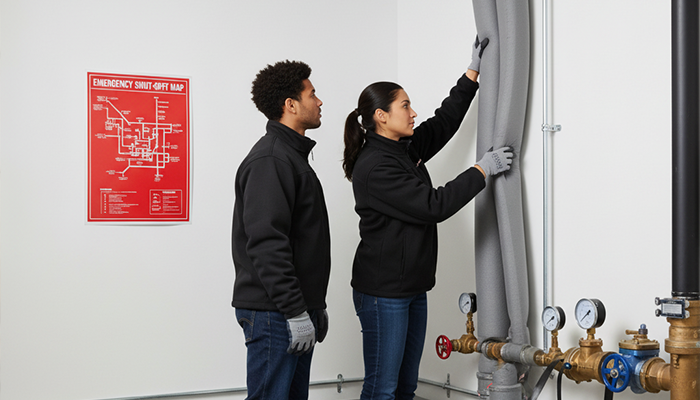
Insulate exposed lines in mechanical rooms, crawl spaces, and exterior walls. Add heat tape where needed and verify freeze protection setpoints. Post shut-off maps so staff can act fast if a line bursts.
Test Fire Protection and Life Safety Systems
Confirm sprinkler heat tracing and antifreeze loops are in spec. Inspect fire pumps, flow switches, alarms, and emergency lighting. Cold snaps should not disrupt suppression or egress during an event.
Power, Generators, and Battery Backups
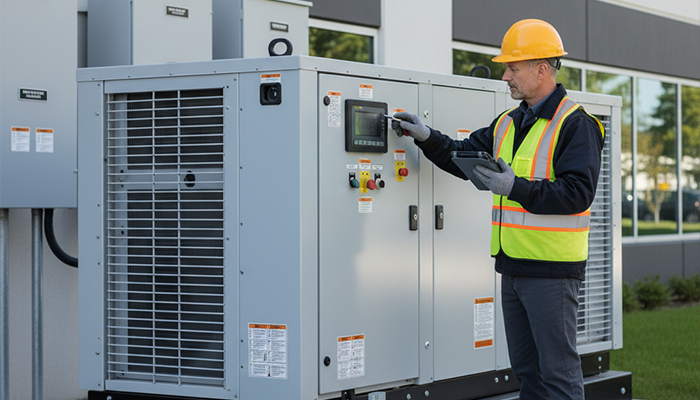
Run-test generators under load and top off fuel. Check transfer switches and battery backups for IT rooms, security panels, and access control. Label panels and store spare fuses to speed any repair.
Roof, Gutters, and Drainage
Clear debris from roofs, scuppers, and downspouts. Fix blisters, open seams, and loose fasteners before ice forms. Keep drain lines open so meltwater does not pond or leak into occupied space.
Entries, Walkways, and Parking Areas
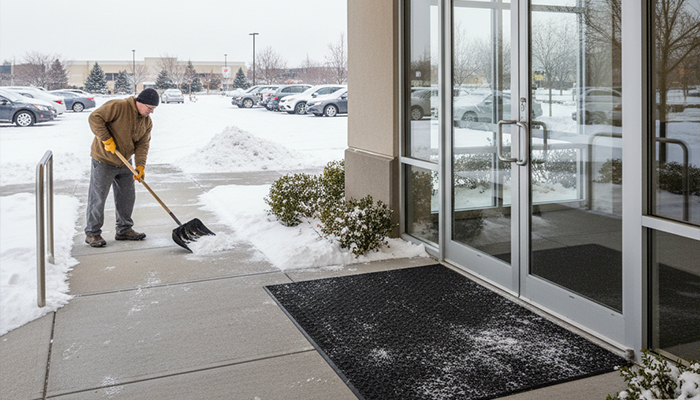
Repair uneven slabs and handrails, then stock ice melt and shovels. Confirm snow removal routes, trigger depths, and vendor response times. Good lighting and slip-resistant mats reduce injuries at peak traffic hours.
Indoor Air Quality and Ventilation Balance
Cold weather shifts how air moves. Balance dampers, verify outside air settings, and replace MERV-rated filters. Healthy airflow supports comfort while keeping heating loads under control.
Water Heaters and Legionella Risk

Flush heaters, verify temperature setpoints, and clean strainers. Check seldom-used fixtures to prevent stagnation. A simple water management plan reduces Legionella risk through winter.
Elevators, Dock Doors, and Critical Equipment
Lubricate seals and inspect pit heaters for elevators. For docks, service door gaskets, and levelers to limit heat loss. Tag critical equipment with winter procedures and quick-start guides for staff.
Supplies, Vendor Readiness, and Staffing Plans
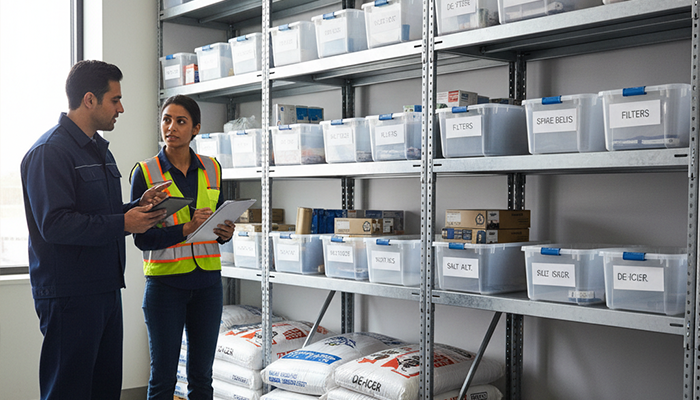
Stock de-icer, salt alternatives, floor mats, filters, and spare belts. Confirm on-call lists, escalation paths, and weekend coverage. This step is core to commercial facility winter preparation, especially for multi-site teams.
- Keep a two-week buffer of consumables
- Pre-approve emergency PO thresholds
- Share vendor response SLAs with tenants
Communication Plan and Tenant Notices
Send clear reminders about space heaters, window use, and after-hours access. Provide a single number or portal for cold-weather issues. Good communication lowers risk and speeds service calls.
Budget, Insurance, and Documentation

Review deductibles, coverages, and any winter-related exclusions. Photograph high-risk areas and log completed work with dates and vendors. Strong records support claims and future planning.
Emergency Preparedness and Cold-Weather Drills
Update flood and freeze response plans and conduct a brief tabletop drill. Practice a pipe-burst scenario that includes shut-offs, water cleanup, and tenant notifications. Minutes matter when water moves.
Data Monitoring and Remote Alerts

Set alerts for low supply air temps, freezestat trips, space temps near 40°F, and pump faults. Even simple sensors help maintenance teams catch small issues early. Use daily checks during a severe cold.
Loading Docks, Corridors, and Back-of-House Spaces
These zones cool fast. Add door sweeps, seal penetrations, and set space heaters with safe clearances. Walk these areas at shift changes to spot drafts, icing, or unsafe storage.
Specialty Spaces and Sensitive Equipment

Server rooms, labs, and food areas have tighter limits. Verify redundancy, alarm paths, and emergency contacts. Post winter SOPs so team members know the exact steps during a power or HVAC event.
Landscaping, Irrigation, and Exterior Fixtures
Winterize irrigation and blow down lines. Wrap hose bibs, protect backflow preventers, and check site lighting timers. Trim branches that could fall on roofs, cars, or power lines after heavy snow.
Post-Storm Inspection and Recovery Steps
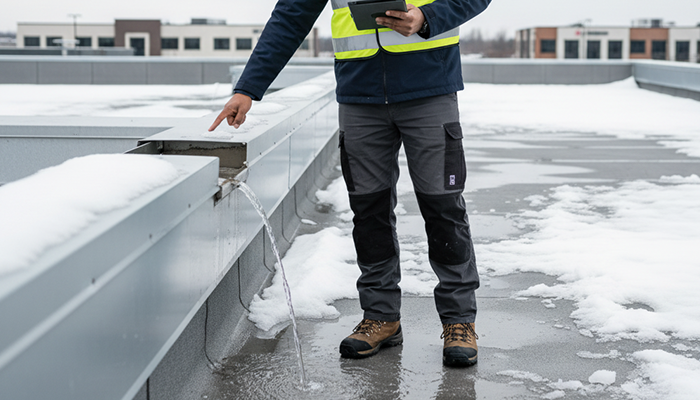
After each event, walk the roof, verify drains, and check mechanical rooms for leaks. Document findings and close work orders within 48 hours. Quick recovery prevents small issues from escalating.
Planning Timeline to Keep Work on Track
Break the work into three waves so tasks do not pile up when the first freeze hits. Do envelope repairs, roof maintenance, and HVAC service in early fall while access is easy and parts are available. Stock supplies and confirm vendors well before storms start to hit.
In late fall, run your drills and verify remote alerts. As deep winter approaches, tighten SOPs and confirm after-hours coverage so your commercial property for winter plan holds up during long weekends and holidays.
How This Checklist Supports Energy and Cost Control

Small fixes deliver real savings over a long season. Tight seals, clean filters, and balanced ventilation reduce load on the heating plant. Equipment that runs within spec also lasts longer and needs fewer emergency calls.
These steps work together. When airflow is right and doors seal well, the building stays stable and your energy budget is easier to control. The result is steady comfort and fewer mid-winter surprises for commercial building winterization.
What to Document for Next Year
Save photos, invoices, sensor trends, and before-and-after notes. Track when you saw the first frost, the first heavy snow, and any freeze alerts. Good records make next year’s commercial property for winter plan faster and more accurate.
Close each work order with vendor names, part numbers, and warranty terms. Tag assets with service dates and expected follow-ups. When spring comes, you will have a clear record of what worked and what needs earlier attention.
A Winter-Ready Mindset Pays Dividends
Winter rewards buildings that are ready. Use this checklist to spot risks early and keep people safe. A little planning today can spare you a big repair tomorrow.
Maintenance Specialists Inc. offers a wide range of commercial property maintenance services. Call us now at 704.405.6000 or contact us online for more details!
Related Article:

